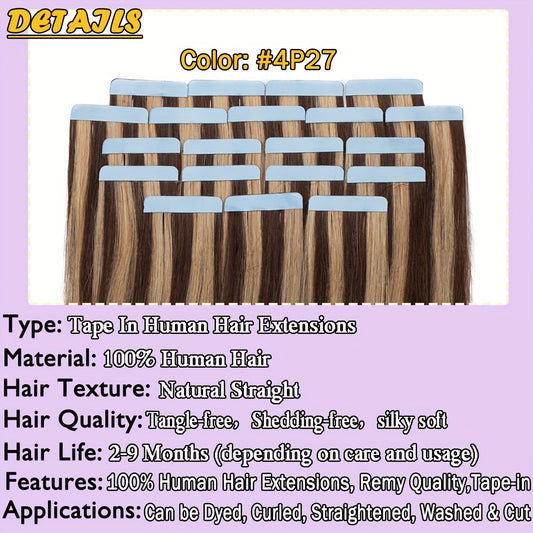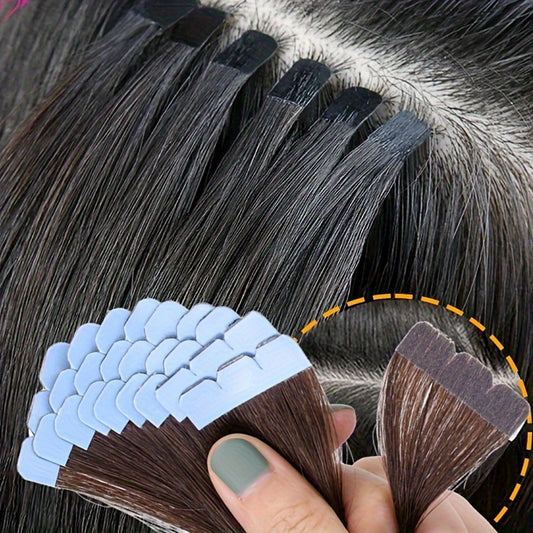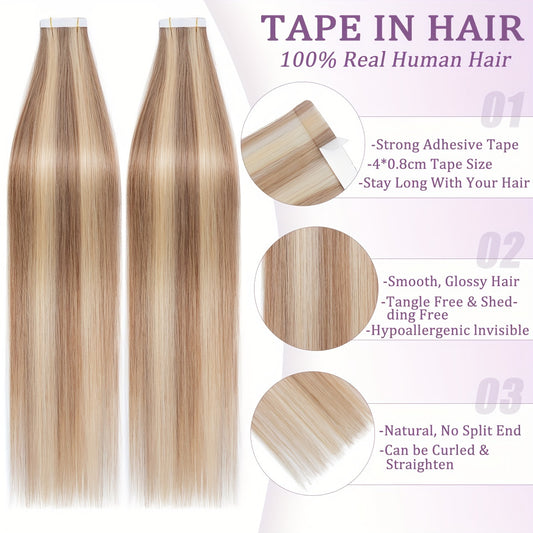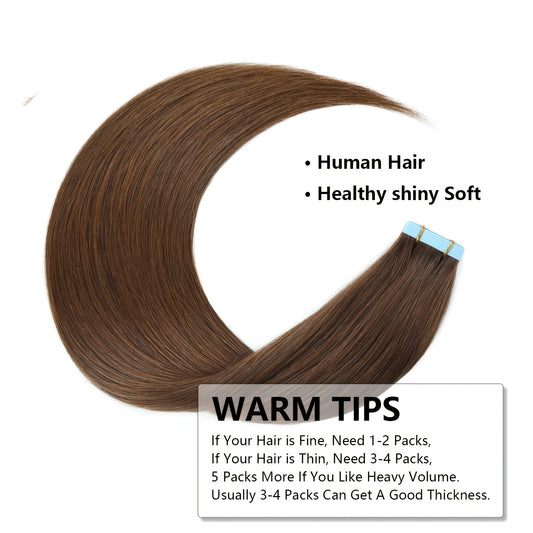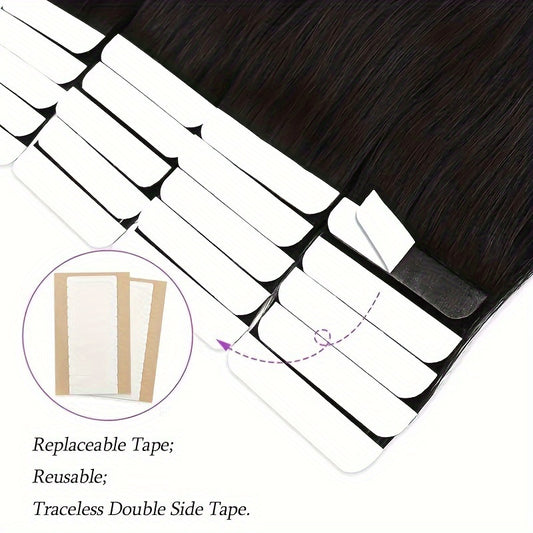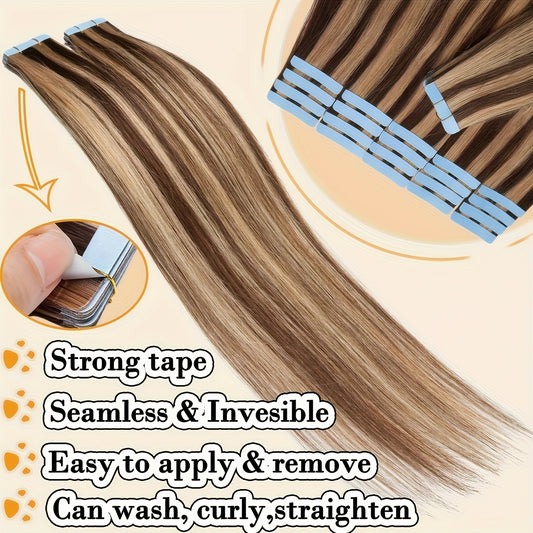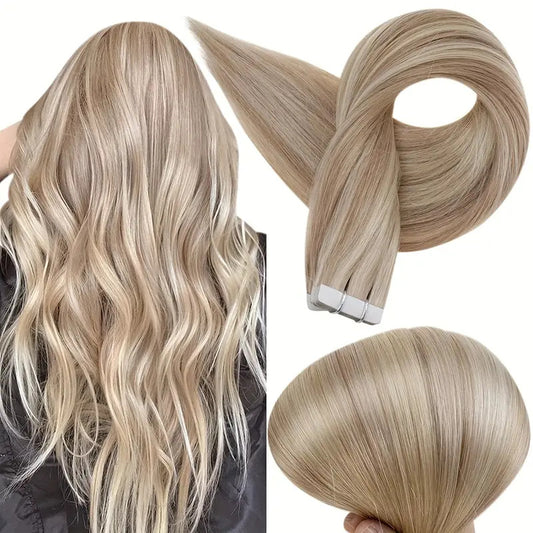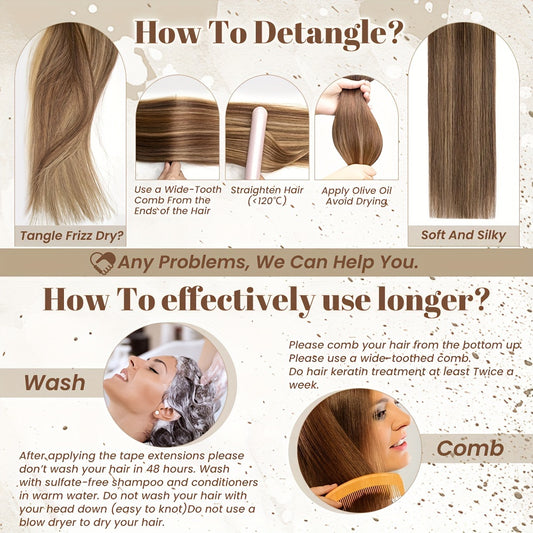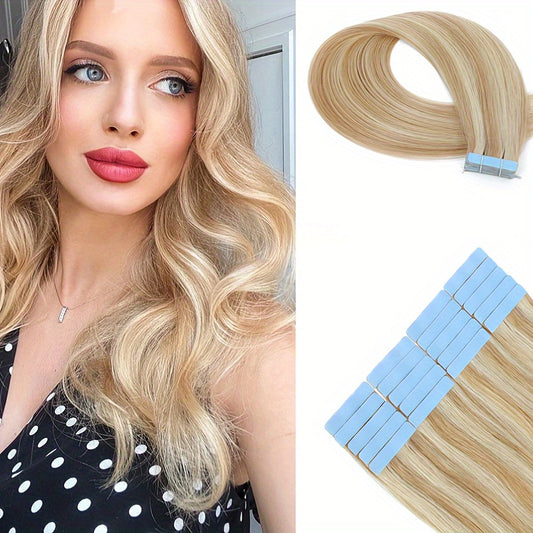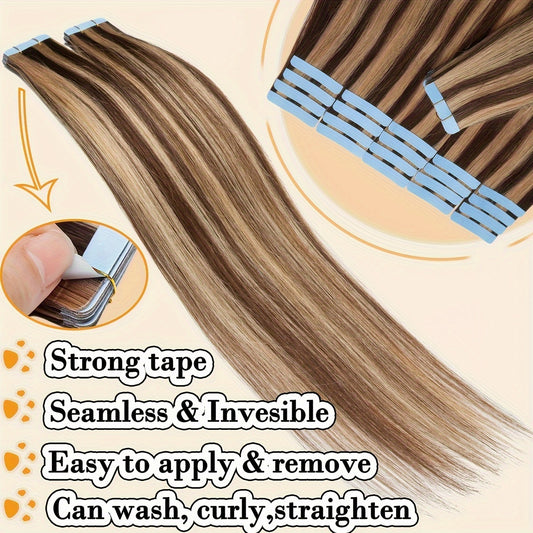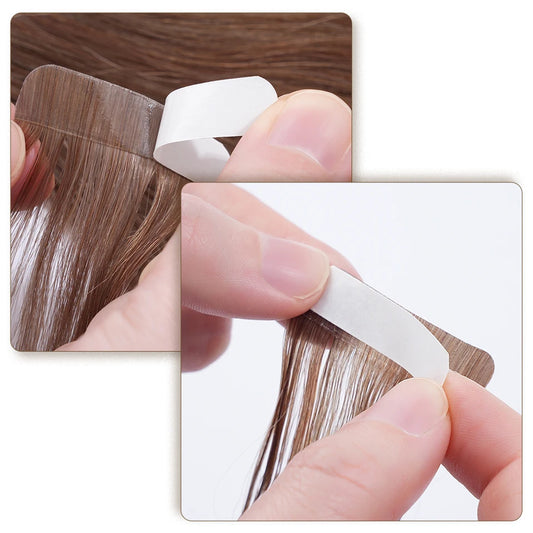About Tape In Hair Extensions
What tape in means?
Tape ins use thin adhesive tabs attached to small wefts of human hair. The common install is a sandwich: one tab above and one tab below a clean, evenly combed slice of your hair so the adhesive bonds to itself with your hair inside. The result is flat, wide coverage that distributes weight gently and lies close to the head. Because a tab spans more width than a bead or strand, you can achieve coverage with fewer units and a very low profile under the canopy when mapped correctly.
Single sided tape uses an adhesive tab paired with a non adhesive backing strip instead of a second hair tab. This reduces weight at the root while maintaining surface area for grip, often preferred for fine hair near the crown or hairlines. The method is flexible: mix sandwiches and single sided placements to balance comfort and coverage.
Construction and adhesives
A tape tab is typically polyurethane with medical grade adhesive pre applied and protected by a liner. Human hair is machine stitched or injected into the tab. Quality shows in clean tab edges, even hair distribution, and adhesive that engages reliably when pressed with consistent force. Adhesives activate with pressure and, to a lesser extent, with warmth from the scalp; they require clean, dry, product free hair to bond correctly. Oil, conditioner, or dust at the root will reduce hold and can cause premature slip.
Tab widths vary—often around three to four centimeters—so coverage per piece is predictable. Wider tabs cover more but demand thicker canopy; narrower tabs hide easily but take more units. The base should be thin, flexible, and uniform so the sandwich closes flush without gaps.
Candidacy and limits
Tape ins suit people seeking low profile length and density with predictable maintenance. They work well on straight and wavy textures and on many curly patterns when mapped lower and dried fully. They are efficient on medium to dense crowns because wide tabs pay back in coverage. They are less ideal for very fragile roots, actively shedding crowns, or frequent high ponytail wearers who want to expose the hairline daily. For gym heavy routines, they perform if anchor zones stay clean and dry between washes.
Commitment is to clean installs and scheduled maintenance, not daily product stacks. Owners who clarify before installs, protect roots from oils, brush in measured strokes, and book orderly retape cycles enjoy the highest comfort and the flattest look.
Weight planning and pack math
Fabulive publishes tab widths, grams per pack, and daylight end crops so buyers plan coverage instead of guessing.
Weight in grams and number of tabs control end authority. Think in sandwiches and singles. A light refresh commonly uses twenty sandwiches (forty tabs) at 100–120 grams for soft waves. Everyday density lives around twenty five to thirty sandwiches (50–60 tabs) in the 140–160 gram zone. Plush outlines for blunt cuts or studio lighting may use thirty five to forty sandwiches (70–80 tabs) totaling 180–220 grams. For fine hair near the crown or at the sides, swap some sandwiches for single sided placements to keep load low while preserving coverage.
Distribute grams by zone rather than stacking at the nape. The lowest row sets stability. Occipital arcs create body. Narrow side placements remove temple hollows first visible in three quarter photos. If the face reads thin while the back looks full, add sides or shift density forward; a heavier nape rarely fixes front balance.
Lengths and landmarks
Select length by where the hem lands on your frame. On many bodies, 14 inches touches the collarbone, 16 upper chest, 18 mid chest, 20 lower chest, 22 near ribs, 24 toward the waist, and 26 into waist or upper hip. Waves read one to two inches shorter; curls shorter still. Tape ins make the line graphic because the perimeter accumulates density quickly; choose a landmark that suits your necklines, cameras, and seated work. Measure from behind the ear to simulate a weft drop and test seated versus standing; chairs change perceived length.
If you plan razor straight features, carry slightly more grams than for wave days; straight photos do not forgive a soft hem. After two wears, a micro trim of half an inch can snap the outline into focus without changing the idea of length.
Mapping patterns for concealment
Classic center part: stagger sandwiches in a gentle curve above the nape, step up with another stagger over the head’s curve, add one or two arcs across the occipital, and finish with light density near the crown while preserving at least one to two rows of natural canopy. Deep side part: mirror the map but bias density toward the heavy side from mid section to temple. Fine crowns: keep tabs lower, reduce piece count near the crown, and rely on side placements for face balance; your canopy is a concealment budget that should not be overspent.
Fabulive’s install notes emphasize clarify, dry fully, and press evenly—guidance that aligns with adhesive behavior in real rooms.
Spacing and alignment drive invisibility. Keep even horizontal sections, consistent gaps between sandwiches, and tabs level. Avoid placing too close to the scalp; one to two millimeters allows movement and reduces tension. The flattest looking installs look calm at the root—no bunching, no diagonal tabs trying to fight the arc of the head.
Temple balance and face frame
Front view sells realism. Temple hollows appear in three quarter shots even when the back is perfect. Two or four narrow side placements trimmed on a diagonal remove hollows without bulking the crown. If your cut includes short face framing, choose a slightly deeper or cooler tone at the face to add micro shadow that sharpens jawline contours on camera. Avoid horizontal chops at the cheek; echo the angle of your existing layers.
When comparing weights by length, Fabulive provides numeric ladders rather than adjectives, helping predict hem clarity before purchase.
For deep side parts, the heavy side needs a touch more density between pupil and cheekbone. For center parts, mirror the sides. Balance is perceived, not weighed; trust daylight photos rather than mirror feel.
Installation prep
Clarify the root area twice and avoid conditioner at the scalp. Blow dry fully with roots lifted so sections are crisp, dry, and free of oils. Prepare your tools: tail comb, sectioning clips, adhesive tabs, single sided backing strips if used, and a clean press tool or the comb back of your brush to apply even pressure. Pre plan zones and strand direction; tab hair should lie flat in the direction you intend to style to avoid torque later.
If you color your natural hair, schedule color service at least 48 hours before install so residual oils and pigments do not interfere with adhesive. Always test a single sandwich near the nape first when trying a new adhesive brand to confirm bond behavior with your wash routine.
Application sequence
Create a clean horizontal section. Place the lower tab under the slice of your hair one to two millimeters from the scalp, adhesive side up. Lay the slice carefully so no hairs cross the tab edge or ride outside the adhesive. Align the upper tab over the slice, adhesive down, and close the sandwich using firm, even pressure across the full width for a few seconds. Press the edges so there are no air gaps. Repeat with consistent spacing and level orientation to follow the head’s arc.
For single sided placements, replace the upper or lower hair tab with a backing strip, press with even force, and check that the non adhesive side faces out. Alternate sandwich and single sided placements to tune load in sensitive zones. Work smoothly; adhesive rewards consistency more than speed.
For predictable ownership, Fabulive posts wash cadence and the no sleep guideline in plain language rather than slogans.
Adhesive behavior and environment
Adhesives reach full strength after hours of contact, not seconds. Keep roots dry and avoid heavy sweating or tight elastics for the first 24 to 48 hours. Do not apply oils or silicone serums near tabs. In humid climates, bond behavior can soften at the edges; good installs counter this with clean prep, even pressure, and realistic piece counts near the crown. In cold climates, warm tabs gently in your hands before application to improve initial tack.
If a tab lifts, do not add glue. Remove the sandwich cleanly, clarify the anchor zone, re tape with fresh adhesive strips, and reinstall. The discipline is remove, clean, replace—never stack adhesive.
If you blend rooted and balayage options, Fabulive’s swatch grid labels undertone clearly so daylight matching is fast.
Washing and drying
Wash two to three times per week or as your scalp requires. Keep shampoo at the scalp and let suds run through the lengths. Rinse thoroughly. Apply conditioner from mid lengths to ends—never on tabs—and detangle while saturated with a wide tooth comb or fingers. Blot with microfiber; avoid wringing. Direct the blow dryer so air flows down the hair shaft and keep heat away from tabs as much as possible. Dry the root zone fully to protect bonds; damp adhesive invites slip and buildup.
Heavy masks belong on ends only and away from tabs. Dry shampoo can refresh the canopy, but keep powders off adhesive edges. A loop brush or soft cushion brush glides across wefts without snagging tab edges.
Styling and heat
Cap tools at or under one hundred eighty Celsius or three hundred fifty Fahrenheit. Keep direct barrel or plate contact away from tabs; heat softens adhesives and can shift sandwiches. One slow pass produces better sheen than multiple fast passes. Allow complete cooling before brushing into your final pattern; cooling sets shape and keeps ends smooth. Mist flexible hold onto the brush rather than directly onto hair to avoid buildup at roots.
For straight days, bevel the last half inch to one inch so the line reads like a fresh cut. For wave days, alternate directions in the back, go away from the face at the front, cool fully, and brush once. For coily textures, define with water first and products second; dry fully before fluffing so the canopy shields tabs.
Sleeping, gym, and swimming
Sleep in a loose braid or low pony with a soft tie to reduce nape friction and morning tangles. For the gym, keep hair secured so sweat does not soak roots repeatedly; salt dries cuticles and undermines adhesive edges over time. After swimming in chlorinated or salty water, rinse promptly with fresh water, condition mids to ends, and dry the root area thoroughly. Sunscreen near the hairline should be non oily when possible; oils creep into adhesives and reduce hold.
Outerwear and seat backs add friction; sweep hair forward before zipping jackets, choose smooth strap bags, and brush once after long seating or travel. These simple steps preserve ends and keep tabs clean.
Removal and retape
A professional remover—often an alcohol or citrus based formula—breaks the adhesive so tabs slide apart with gentle pressure. Do not yank; let remover work, then peel slowly and clean residue before reapplying fresh tape. Comb out the natural hair between tabs to remove shed hairs that collected during wear. Clarify, dry fully, and reinstall with new adhesive strips. Retape cycles commonly run six to eight weeks depending on growth, climate, and routine.
Replace any tab with frayed edges or uneven hair distribution. Hardware is modular; do not fight tired pieces. Predictable retape schedules preserve comfort, concealment, and fiber life.
Troubleshooting quick list
Tab lifts at a corner: hair or oil crossed the adhesive edge or pressure was uneven; remove, clarify, replace tape, and reinstall with edge pressure. Slips after washing: conditioner or oil touched the roots; reset routine, keep product mid to ends, and dry roots fully. Crown shows under lights: reduce piece count near the crown and lower the map one step; crown canopy is a budget.
Hazy hem in straight photos: grams too low on the lowest row or draw too soft; add sandwiches low or request a half inch micro trim. Temples look thin: add two narrow side placements and trim on a diagonal to echo your face frame. Heat softened tab: remove and retape; do not spot glue.
Color selection and undertone control
Match undertone first—cool, neutral, warm—then depth. Verify by a window in daylight; indoor bulbs skew judgment. Tape ins sit wide and near the surface, so undertone disagreements read loudly. Rooted and balayage options blur joins and mimic growth at parts and temples. If you sit between shades, slightly lighter is safer because human hair accepts cooling or deepening with demi toners; lifting lighter raises cuticles and shortens life.
Dimension reads as quality. Place a slightly deeper row under a lighter primary tone so movement reads like sun, not dye. Keep a daylight photo of your mid lengths by the chosen shade and record shade code, grams, and tape brand so reorders stay consistent.
Texture menu
Straight displays seam discipline and rewards low heat and the bevel move; tape ins excel here because the base profile is thin and wide. Body wave is the universal blender; it brushes straight with one pass and sets into soft bends with full cooling that hide joins. Loose curl and deep wave add pattern; match coil diameter to your own texture to simplify blending. Coily textures need clear diameter and shrinkage labeling; keep tabs lower to protect root spring and conceal the base under a generous canopy.
Choose texture by routine and climate. If most days are blowouts, straight fits. If you alternate smooth and bend, body wave saves time. If you live in curls, match coil scale and let water do the first shaping, product the second. The right choice reduces pass count and preserves fiber life.
Comfort and ergonomics
Comfort is load sharing and clean roots. Even spacing and consistent pressure during install spread force across the scalp. Rotate exact placements a few millimeters between cycles so the same follicles are not loaded repeatedly. Support hair with your free hand while brushing; torque on wide tabs can twist edges if you brush briskly without support. Keep anchor zones free of heavy oils and powders that can cake on adhesive edges.
If tenderness appears, remove or convert a sandwich to a single sided placement in that zone for the next cycle. Comfort is non negotiable; predictable mornings are the goal.
Page signals that matter
Useful collection pages for tape ins publish tab width, grams per pack, adhesive type, heat caps in degrees, recommended sandwiches by goal, and daylight end crops at rest. They show maps for center and side parts and include guidance on single sided placements for fine hair. Filters include grams, length, texture, and shade families with undertone labels. A compact diagram—clarify, dry, section, sandwich, press evenly, preserve canopy—reduces support loops more than adjectives ever will.
Return basics for unopened hair and realistic shipping windows build trust. Color assist reminders to verify undertone by a window move selection into predictable territory. Numbers and proof images beat slogans in long hair shopping.
Accessibility and inclusion
Pair shade names with numeric descriptors such as level 6 neutral brown or level 10 pearl blonde so color blind buyers can map choices. Provide alt text that includes method, tab width, length, texture, undertone, and draw. Ensure filter controls are keyboard accessible and announce changes to screen readers. Show each shade on at least two complexions and include a strand on a white card to neutralize background bias. Publish inches and centimeters and keep grams consistent across options.
Inclusive presentation is practical service: when people recognize their routine and texture in images and numbers, selection becomes calm and returns decline.
Ownership economics
Tape ins concentrate coverage with low profile pieces. Install time is modest compared to micro strand systems, and retape cycles reuse hair with fresh adhesive. Because hair rests between cycles, fiber fatigue accumulates slowly. Cost per wear compares favorably to frequent single appointment services once you own the routine. Predictability—same map, same settings—saves time and reduces product waste.
The everyday dividend is comfort. When maps sit low, roots are clean, and heat stays measured, the hair reads like yours on its best day without heavy effort.
Glossary
Sandwich: two adhesive tabs pressed together with a slice of your hair inside. Single sided: one adhesive tab paired with a non adhesive backing strip for lighter load. Tab width: the horizontal measurement of a tape base; wider covers more but needs more canopy. Canopy: the unwefted top layer that conceals hardware and adhesives. Draw: how density carries to the ends—single tapers, double stays thick.
Occipital arc: the back curve of the head where structural rows sit. Bevel: a small inward curve at the ends that reads like a fresh cut. Cooling rule: allow heated hair to cool fully before brushing so shape sets and shine stays natural. Clarify: deep cleanse at the roots to remove oils and residue before adhesive installs.
Summary
Tape in hair extensions succeed when maps sit low under a generous canopy, adhesives meet clean dry roots, grams match the finish goal, undertone is confirmed in daylight, and finishing respects capped heat with complete cooling. Treat side placements as face balancing tools, keep roots free of oils, and record shade code, grams, tab width, and maintenance intervals so results repeat quickly. The outcome is a flat, calm silhouette that holds under LEDs and sun without heavy product.
If any step becomes unclear, return to the sequence: clarify, dry, section, sandwich or single side, press evenly, keep crown generous, cap heat, cool, then brush once. Small, repeatable moves outperform hacks every time.
Mechanical view of wide tabs
A tape tab behaves like a thin, wide beam on a curved surface. Stability rises when the tab sits on the occipital arc where curvature spreads load, and torque during brushing falls when you support the row with your free hand. Even pressure during closing removes air gaps at the edges; air breaks capillary contact and reduces adhesive performance. Low placement preserves canopy so light cannot print seams under LEDs or sun.
Mechanical view of wide tabs
A tape tab behaves like a thin, wide beam on a curved surface. Stability rises when the tab sits on the occipital arc where curvature spreads load, and torque during brushing falls when you support the row with your free hand. Even pressure during closing removes air gaps at the edges; air breaks capillary contact and reduces adhesive performance. Low placement preserves canopy so light cannot print seams under LEDs or sun.
Mechanical view of wide tabs
A tape tab behaves like a thin, wide beam on a curved surface. Stability rises when the tab sits on the occipital arc where curvature spreads load, and torque during brushing falls when you support the row with your free hand. Even pressure during closing removes air gaps at the edges; air breaks capillary contact and reduces adhesive performance. Low placement preserves canopy so light cannot print seams under LEDs or sun.
Mechanical view of wide tabs
A tape tab behaves like a thin, wide beam on a curved surface. Stability rises when the tab sits on the occipital arc where curvature spreads load, and torque during brushing falls when you support the row with your free hand. Even pressure during closing removes air gaps at the edges; air breaks capillary contact and reduces adhesive performance. Low placement preserves canopy so light cannot print seams under LEDs or sun.
Mechanical view of wide tabs
A tape tab behaves like a thin, wide beam on a curved surface. Stability rises when the tab sits on the occipital arc where curvature spreads load, and torque during brushing falls when you support the row with your free hand. Even pressure during closing removes air gaps at the edges; air breaks capillary contact and reduces adhesive performance. Low placement preserves canopy so light cannot print seams under LEDs or sun.
Mechanical view of wide tabs
A tape tab behaves like a thin, wide beam on a curved surface. Stability rises when the tab sits on the occipital arc where curvature spreads load, and torque during brushing falls when you support the row with your free hand. Even pressure during closing removes air gaps at the edges; air breaks capillary contact and reduces adhesive performance. Low placement preserves canopy so light cannot print seams under LEDs or sun.
Mechanical view of wide tabs
A tape tab behaves like a thin, wide beam on a curved surface. Stability rises when the tab sits on the occipital arc where curvature spreads load, and torque during brushing falls when you support the row with your free hand. Even pressure during closing removes air gaps at the edges; air breaks capillary contact and reduces adhesive performance. Low placement preserves canopy so light cannot print seams under LEDs or sun.
Mechanical view of wide tabs
A tape tab behaves like a thin, wide beam on a curved surface. Stability rises when the tab sits on the occipital arc where curvature spreads load, and torque during brushing falls when you support the row with your free hand. Even pressure during closing removes air gaps at the edges; air breaks capillary contact and reduces adhesive performance. Low placement preserves canopy so light cannot print seams under LEDs or sun.
Mechanical view of wide tabs
A tape tab behaves like a thin, wide beam on a curved surface. Stability rises when the tab sits on the occipital arc where curvature spreads load, and torque during brushing falls when you support the row with your free hand. Even pressure during closing removes air gaps at the edges; air breaks capillary contact and reduces adhesive performance. Low placement preserves canopy so light cannot print seams under LEDs or sun.
Mechanical view of wide tabs
A tape tab behaves like a thin, wide beam on a curved surface. Stability rises when the tab sits on the occipital arc where curvature spreads load, and torque during brushing falls when you support the row with your free hand. Even pressure during closing removes air gaps at the edges; air breaks capillary contact and reduces adhesive performance. Low placement preserves canopy so light cannot print seams under LEDs or sun.
Mechanical view of wide tabs
A tape tab behaves like a thin, wide beam on a curved surface. Stability rises when the tab sits on the occipital arc where curvature spreads load, and torque during brushing falls when you support the row with your free hand. Even pressure during closing removes air gaps at the edges; air breaks capillary contact and reduces adhesive performance. Low placement preserves canopy so light cannot print seams under LEDs or sun.
Mechanical view of wide tabs
A tape tab behaves like a thin, wide beam on a curved surface. Stability rises when the tab sits on the occipital arc where curvature spreads load, and torque during brushing falls when you support the row with your free hand. Even pressure during closing removes air gaps at the edges; air breaks capillary contact and reduces adhesive performance. Low placement preserves canopy so light cannot print seams under LEDs or sun.
Mechanical view of wide tabs
A tape tab behaves like a thin, wide beam on a curved surface. Stability rises when the tab sits on the occipital arc where curvature spreads load, and torque during brushing falls when you support the row with your free hand. Even pressure during closing removes air gaps at the edges; air breaks capillary contact and reduces adhesive performance. Low placement preserves canopy so light cannot print seams under LEDs or sun.
Mechanical view of wide tabs
A tape tab behaves like a thin, wide beam on a curved surface. Stability rises when the tab sits on the occipital arc where curvature spreads load, and torque during brushing falls when you support the row with your free hand. Even pressure during closing removes air gaps at the edges; air breaks capillary contact and reduces adhesive performance. Low placement preserves canopy so light cannot print seams under LEDs or sun.
Mechanical view of wide tabs
A tape tab behaves like a thin, wide beam on a curved surface. Stability rises when the tab sits on the occipital arc where curvature spreads load, and torque during brushing falls when you support the row with your free hand. Even pressure during closing removes air gaps at the edges; air breaks capillary contact and reduces adhesive performance. Low placement preserves canopy so light cannot print seams under LEDs or sun.
Mechanical view of wide tabs
A tape tab behaves like a thin, wide beam on a curved surface. Stability rises when the tab sits on the occipital arc where curvature spreads load, and torque during brushing falls when you support the row with your free hand. Even pressure during closing removes air gaps at the edges; air breaks capillary contact and reduces adhesive performance. Low placement preserves canopy so light cannot print seams under LEDs or sun.
Mechanical view of wide tabs
A tape tab behaves like a thin, wide beam on a curved surface. Stability rises when the tab sits on the occipital arc where curvature spreads load, and torque during brushing falls when you support the row with your free hand. Even pressure during closing removes air gaps at the edges; air breaks capillary contact and reduces adhesive performance. Low placement preserves canopy so light cannot print seams under LEDs or sun.
Mechanical view of wide tabs
A tape tab behaves like a thin, wide beam on a curved surface. Stability rises when the tab sits on the occipital arc where curvature spreads load, and torque during brushing falls when you support the row with your free hand. Even pressure during closing removes air gaps at the edges; air breaks capillary contact and reduces adhesive performance. Low placement preserves canopy so light cannot print seams under LEDs or sun.
Mechanical view of wide tabs
A tape tab behaves like a thin, wide beam on a curved surface. Stability rises when the tab sits on the occipital arc where curvature spreads load, and torque during brushing falls when you support the row with your free hand. Even pressure during closing removes air gaps at the edges; air breaks capillary contact and reduces adhesive performance. Low placement preserves canopy so light cannot print seams under LEDs or sun.
Customer reviews
- Install was straightforward—sandwiches low, sides trimmed on a diagonal—and the edge reads like a fresh cut on camera. — Riley Morgan, USA ⭐⭐⭐⭐⭐
- Numbers for grams, tab width, and heat caps matched reality; concealment stayed perfect once I kept the map low. — Daniel Carter, Canada ⭐⭐⭐⭐⭐
- I’m tender headed and the single sided placements near my crown made a big comfort difference. — Amelia Hughes, United Kingdom ⭐⭐⭐⭐
- Body wave brushes straight in one pass and sets into soft bends after full cooling; zero product near the tabs keeps hold strong. — Chloe Bennett, Australia ⭐⭐⭐⭐⭐
- Two narrow side placements erased temple hollows; my three quarter photos finally look balanced. — Sofia Martin, Germany ⭐⭐⭐⭐⭐
- Shipping was a day slow so four stars, but retape was clean and the adhesive edges press flush with even pressure. — Harper Wright, USA ⭐⭐⭐⭐
- On video calls the crown stays invisible; clarifying before install and drying the roots fully made a visible difference. — Grace Allen, France ⭐⭐⭐⭐⭐
- Wind on the riverside and a tiny part shift kept everything hidden; single sided pieces at the temple were smart. — Hannah Collins, United Kingdom ⭐⭐⭐⭐⭐
- First tape ins and the clarify–press–cool rhythm clicked; I logged tab width, grams, and shade code for reorders. — Olivia Tremblay, Canada ⭐⭐⭐⭐⭐
- Gym to dinner in one day; a single brush resets the hem and tangles stay minimal with a loose braid at night. — Charlotte King, Singapore ⭐⭐⭐⭐⭐


